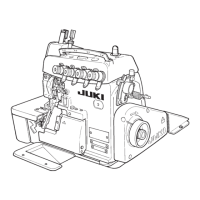AMS-223C, 224C, 223P, 224P (September, 2003) 1/4
AMS223
Code
S
B
T
L
Feeding frame type
Standard (pneumatic monolithic feeding frame)
Pneumatic double-stepped stroke feeding frame
Pneumatic inverted clamp
(with a double-stepped stroke feeding frame)
Pneumatic separately-driven feeding frame
(with a double-stepped stroke feeding frame)
● Best-suited for sewing processes to attach small parts onto shoes or bags,
attach pockets onto garments, sew decorative stitches, etc.
● There is sufficient area under the arm (sewing area + free space 290mm
(AMS-223C) or 240mm (AMS-224C)).
● The feeding frame can go up as high as 30mm, which means that a heavy-
weight material can be handled with ease.
● The feeding frame can also be manually lowered. This allows the operator
to finely adjust the position of the material to be sewn.
● The machine is capable of sewing at a speed as high as 2,000rpm
(when the stitch length is set to 3mm (AMS-223C) or 2.7mm (AMS-224C)).
● The machine is equipped with a large hook which reduces the frequency that
the bobbin thread needs to be replaced.
● The machine ensures accurate stitching with a resolution as precise as 0.1mm.
● The newly-developed XY mechanism further improves strength and rigidity of
the feed.
● Thread trimming mechanism ensures highly-improved reliability.
AMS-223C
〈Sewing area: 200mm(L)×300mm(W)〉
AMS-224C
〈Sewing area: 250mm(L)×400mm(W)〉
Computer-controlled Cycle Machine with Input Function
● As a result of JUKI's thorough study of sewing performance, the area in which
hitch stitches appears is reduced to one-third or less of the area produced
with conventional cycle machines. Consequently, the sewing area finished
with perfect stitches is enlarged, and the seam quality of top stitches is
further upgraded.
● Since the feeding direction of the hitch stitching area is restricted to a range
of 5˚to 55˚, each of the four different feeding directions (0˚, 90˚, 180˚and
270˚) used to sew the four sides of a rectangular label can be finished with
perfect stitching.
AMS-223P
〈Sewing area: 200mm(L)×300mm(W)〉
AMS-224P
〈Sewing area: 250mm(L)×400mm(W)〉
Computer-controlled Cycle Machine with Input Function
for Wider Area Perfect Stitching
• For the machine with sewing specification G, the feeding
frame that can be used with it is limited to S, B or L.
AMS224 B
Code
S
H
G
Application
Standard
For medium-weight materials
For heavy-weight materials with
double-capacity shuttle hook
Code
Y
B
Option
Not provided
Automatic
bobbin changer
Code
C
P
Machine head type
Standard
Wider-area perfect stitching*
Code
5000
5001〜
Subclass
Standard
Subclass
Code
C
D
Pedal switch
Standard
(2-pedal unit)
3-pedal unit
(PK47)
Code
D
Pedal switch
3-pedal unit
(PK47)
Code
B
Feeding frame
type
Pneumatic
double-stepped
stroke feeding
frame
Code
D
E
H
F
G
J
K
Power supply
100〜130V
Single-phase 190〜250V
U.S.A.,115V
190〜250V
3-phase
380〜440V
U.S.A.,220V
(JE)380V
AMS-223C
WHEN YOU PLACE ORDERS
• AC 2P motor is used for the
sewing application type G.
*For the AMS-223P and AMS-224P,
only the application S and H are
applicable.

